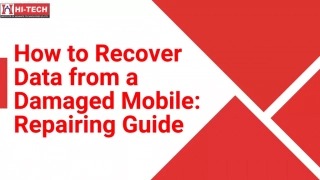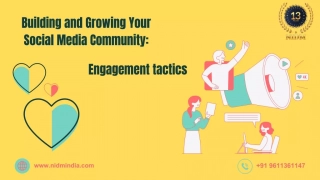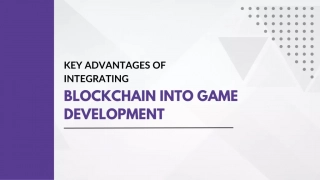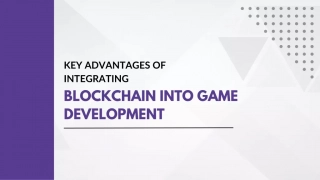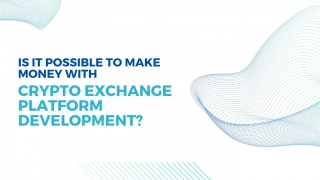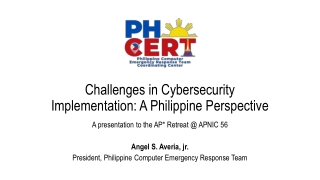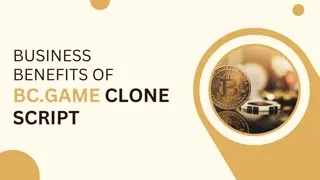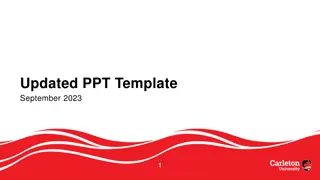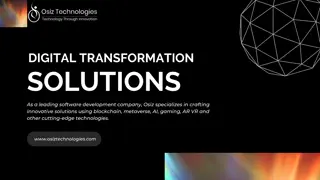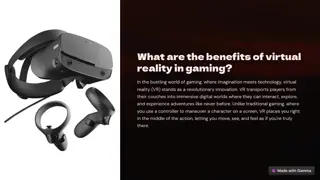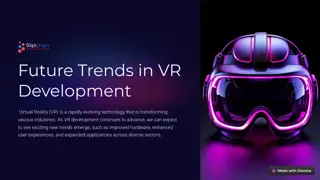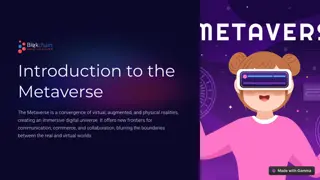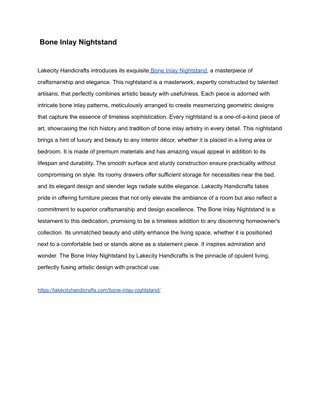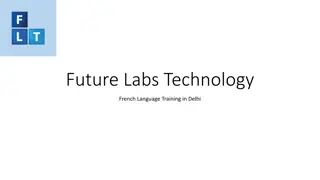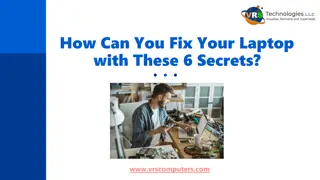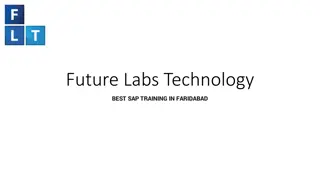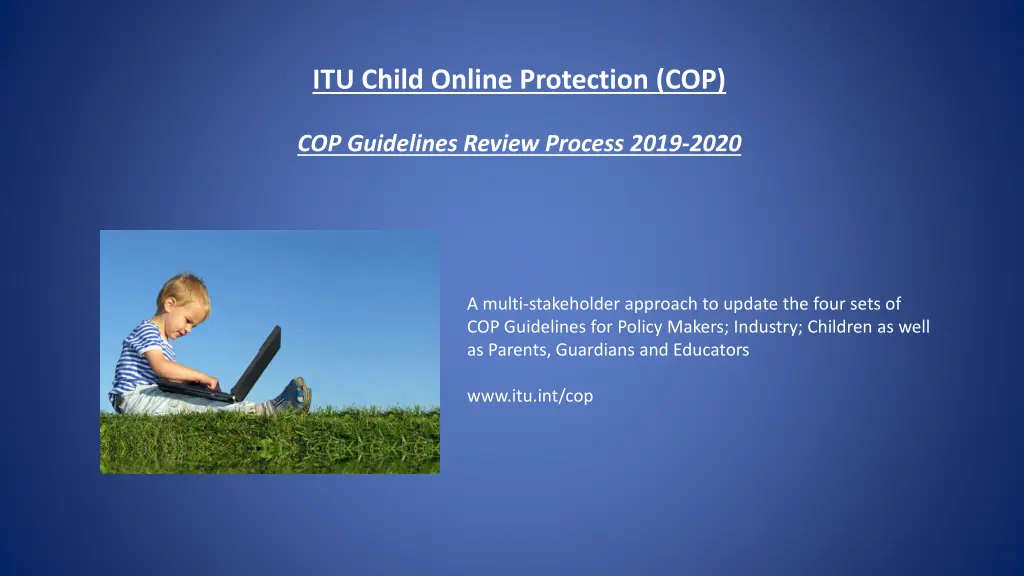
ITU Child Online Protection Guidelines 2019-2020 Review
The ITU, in collaboration with COP partners, is updating COP Guidelines to address technology developments and advocate for children with disabilities. The process includes input from various stakeholders and builds on existing international efforts for Child Online Protection.
Download Presentation

Please find below an Image/Link to download the presentation.
The content on the website is provided AS IS for your information and personal use only. It may not be sold, licensed, or shared on other websites without obtaining consent from the author. If you encounter any issues during the download, it is possible that the publisher has removed the file from their server.
You are allowed to download the files provided on this website for personal or commercial use, subject to the condition that they are used lawfully. All files are the property of their respective owners.
The content on the website is provided AS IS for your information and personal use only. It may not be sold, licensed, or shared on other websites without obtaining consent from the author.
E N D
Presentation Transcript
ITU Child Online Protection (COP) COP Guidelines Review Process 2019-2020 A multi-stakeholder approach to update the four sets of COP Guidelines for Policy Makers; Industry; Children as well as Parents, Guardians and Educators www.itu.int/cop
Background and scope According to Resolution 179, ITU in collaboration with COP Initiative partners and COP Partners have been instructed to update the 4 sets of guidelines taking into consideration two main aspects 2. Children with disabilities and with special needs 1. Technology developments in the telecommunication industry The Secretariat together with the working group on the Guidelines Review has included elements related to online gaming, AI technologies, robotics and connected toys The secretariat has included an element on the special situation of children with disabilities in each set of Guidelines
Initial Statements The Working Group on the Guidelines Review Process acknowledged already existing efforts on Child Online Protection and aims to further build on a collaborative and inclusive approach to the issue within the international community. Therefore the Guidelines will refer to existing 2. Recommendations such as e.g. 1. Models such as e.g. Report on Child Online Protection and Child Online Safety + Child Online Safety Universal Declaration (Broad Band Commission, 2019) Model National Response (Preventing and Tackling Child Sexual Exploitation and Abuse) The Global Threat Assessment 2019 Guidelines to respect, protect and fulfil the rights of the child in the digital environment (Council of Europe, 2018)
Initial Statements The working group further recognizes other international efforts and is informed on 2. Jurisprudential developments such as 1. Normative developments such as Adoption of an opinion on child sexually suggestive or explicit images and/or videos generated, shared and received by children by the Lanzarote Committee, eSafety Commission in Australia Days of discussion on the rights of the child online by the UN Committee on the Rights of the Child and the African Committee of Experts on the Rights and Welfare of the Child New legal framework under New Zealand s Harmful Digital Communications Act General Comment on children s rights in relation to the digital environment by the Committee on the rights of the child
Process and related working methods Step 2 Step 1 1. Four working groups (one per each Guideline) were 1. The working group identified missing aspects and agreed created, grouping partners and relevant stakeholders on new structures. according to their interest/field of expertise. 2. The inclusion of relevant inputs began and is ongoing. 2. Each group nominated a leading organization to 3. The methodology and status of the work is presented at coordinate the substance of the inputs to be included. As the meeting of the CWG COP on September 26th in ITU, expert in the related field, the leading organization has a Geneva. facilitator role in terms of the content to be included in the new Guidelines. 3. The subgroups meet virtually every 2 weeks.
Step 3 Step 4 1. The new Guidelines will be drafted by the working group 1. The 4 sets of guidelines will be refined and the final draft including all collected inputs and comments. will be prepared. 2. The first draft version will undergo several consultation 2. The team will prepare for the next steps. rounds within the expert working group.
Time Line Guidelines Review July 2019 February 2020 Activities? July? August? September? October? November? December? January? February? Call? for? volunteers? ? ? ? ? ? ? ? ? ? ? ? ? ? ? ? ? ? ? ? ? ? ? ? ? Assign? partners? to? different? working? groups? and? define? group? leader? ? ? ? ? ? ? ? ? ? ? ? ? ? ? ? ? ? ? ? ? ? ? ? Collect? relevant? material,? invite? additional? relevant? stakeholders,? propose? '? sections/elements'? in? the? text? to? be? updated? ? ? ? ? ? ? ? ? ? ? ? ? ? ? ? ? ? ? ? ? ? ? ? Schedule? call? each? two? weeks? Include? inputs? in? the? text? and? coordinate? with? experts? ? ? ? ? ? ? ? ? ? ? ? ? ? ? ? ? ? ? ? ? ? ? ? Physical? meeting? of? the? experts? at? the? meeting? of? the? CWG? COP? ? ? ? ? ? ? ? ? ? ? ? ? ? ? ? ? ? ? ? ? ? ? ? Draft? the? new? Guidelines? by? the? expert? working? groups? while? further? including? inputs? ? ? ? ? ? ? ? ? ? ? ? ? ? ? ? ? ? ? ? ? ? ? ? ? Refine? the? draft? and? prepare? the? final? version? ? ? ? ? ? ? ? ? ? ? ? ? ? ? ? ? ? ? ? ? ? ? ?
Working Group Policy Makers 1. Policy Makers - group led by OECD and WPGA Child Helpline International RNW Media InHope ChildHood USA Stiftung Digitale Chancen INSAFE COFACE-Families Europe TaC Together against Cybercrime Interpol IWF Council of Europe UK Safer Internet Centre Joint Research Centre of the ECPAT International United Nations Special Rapporteur on the European Commission sale and sexual exploitation of children European Commission London School of Economics United Nations Special Rapporteur on eWorldwide Group (eWWG) and Political Science Violence against Children Global Partnership to end OECD WePROTECT Global Alliance (WPGA) violence against children Paniamor ICMEC Privately SA
Content of the new Guidelines for Policy Makers on Child Online Protection Chapter 1 - Document Overview 1.1 Purpose 1.2 Scope 1.3 Usage of this Guidance 1.4 Target audience Chapter 2 - Introduction 2.1 What is Child Online Protection? 2.2 Children in the digital world 2.3 Childrens use of the Internet 2.4 The Impact of specific technology on children s digital experience 2.5 Key Risks to Children Online 2.6 Key Harms for Children Online 2.7 The Special Situation of Children with disabilities 2.8 Children s perceptions of Online Risks
Content of the new Guidelines for Policy Makers on Child Online Protection Chapter 3 - Preparing for a National Child Online Protection Strategy 3.1 Actors and Stakeholders 3.2 Existing responses for Child Online Protection 3.3 Examples of responses to online harms 3.4 Benefits of a National Child Online Protection Strategy 3.5 Developing a National Strategy Chapter 4 - General Recommendations 4.1 Legal Framework 4.2 Policy and institutional frameworks 4.3 Regulatory framework 4.4 Considerations and Effective implementation
Content of the new Guidelines for Policy Makers on Child Online Protection Chapter 5 - Addressing the Risks 5.1 A National Checklist 5.2 Overarching principles These Guidelines will be published in the follwing formats: 1. Print Version 2. Online PDF Chapter 6 - Reference Material Chapter 7 - Acronyms Appendix
Working Group - Industry 2. Industry group led by UNICEF BBC GSMA Stiftung Digitale Chancen Tencent Games EBU ICMEC The Walt Disney Company eset InHope Trend Micro eWorldwide Group IWF Twitter Facebook Paniamor UNICEF Global Partnership to Privately SA End Violence Against Children RNW Media
Content of the new Guidelines for industry on Child Online Protection Chapter 1 - Document Overview Chapter 2 - Introduction 1.1. Purpose 1.2 Scope 1.3 Overall structure 1.4 Target audience 2.1 What is Child Online Protection? 2.2 Terminology 2.3 Recent findings and background Information including the special situation of children with disabilities 2.4 Existing national and transnational models to keep children safe 2.5 Good Practice
Content of the new Guidelines for Industry on Child Online Protection 3. Key areas or protecting and promoting children s rights These Guidelines will be published in the follwing formats: 4. General guidelines for all related industry 5. Feature-Specific Checklists 1. Print Version 2. Online PDF 5.1 Offer editorially curated content 5.2 Host user-created content 5.3 Connect new users with each other 6. Reference materials 7. Acronyms
Working Group Children 3. Children group led by Child Rights Connect/ECPAT International UK Safer Internet Centre Inclusion International Child Consultation HABLATAM INSAFE Western Sydney University Child Rights Connect Joint Research Centre of the Youth Crime Watch of Nigeria to Deaf kidz international European Commission African Centre for Citizens EBU Orientation London School of Economics and ECPAT International Political Science Youth IGF from the Asia-Pacific / eWorldwide Group Cyberbully.id OHCHR FARO DIGITAL @LiteracyOnline Polish Safer Internet Center IEEE Save the Children ( Romania/Finland)
Update on Group 3 (part 1) Content of the new Guidelines for Children on Child Online Protection The Guidelines for Children have been split into 3, one per age group (under 9 year old; 9-12; 13 and above) Format: The Guidelines for under 9 Year : story book (print and digital) The Guidelinesfor 9 to 12 Year : work book (print and digital) The Guidelines for 13 t0 18 : On social media in format of teaser linking to new COP Guidelines Website (only digital)
Working Group Parents, Carers and Educators 4. Parents, Educators and Legal Guardians group led by INSAFE Polish Safer Internet Center COFACE-Families Europe Insight 2 act Save the Children EBU Internet matters (Finland/Norway/Romania) ECPAT International Joint Research Centre of the TaC Together against Cybercrime European Commission eWorldwide Group UK Safer Internet Centre London School of Economics and FARO DIGITAL Youth and Media/ Berkman Klein Political Science Inclusion International Center Paniamor ICMEC Youth Crime Watch of Nigeria to Parentzone International INSAFE African Centre for Citizens Orientation
Content of the new Guidelines for Children on Child Online Protection 8. Understanding risks and harms 1. Executive Summary 9. The role parents, carers and guardians can 2. Introduction play 3. What is Child Online Protection? 10. Guidelines for Parents, Carers and Guardians 4. Children and Young People in a 11. The role that educators play connected world 12. Guidelines for educators 5. Children with vulnerabilities 6. New and emerging risks and Conclusions challenges Glossary 7. Defining Parents, Guardians and Educators References
Whats next ? 1. Roll-out January-March 2020 At national level (at least one/two countries per region for each set of Guidelines). Through questionaries/workshops/case studies/children consultations etc. with concerned stakeholders (policy makers, private sector, children, parents, educators and legal guardians). 2. Official Launch May 2020
Roll out 2020 Background: As recommended by the last meeting of the CWG COP in September 2019, ITU and partners, encouraged by member states to roll out the four sets of Guidelines, are seeking interest of partners and Member States to roll out the 4 revised and co-authored sets of Guidelines before their official launch in May 2020. Objective: The roll out sessions will support relevant stakeholders in their child online protection efforts. Timeline: The roll out phase is planned within in the period from 10 February to 20 April 2020. Format: Depending on the target audience the format can differ and be further adapted according the specific needs of the interested countries.
Roll out 2020 Roles and expectations: The collaboration of both, partners and Member States, is necessary to undertake the roll outs. Interested Member States are encouraged to support the roll out through covering the venue, experts travel costs and stay and logistics. In the case of the Guidelines for Industry, interested Industry associations should allocate necessary funds and resources. The participating Partners should identify experts to develop and undertake training with regard to the national or regional context in coordination with ITU. In doing this, the ITU COP Guidelines roll out can be beneficial for Member States in enhancing stakeholder interactions.
Roll out 2020 The expected results: The creation of awareness on the topic of child online protection and online risks The enhancement of national expertise on child online protection The capacity building of all relevant stakeholders The initial collection of aspects to be considered for the drafting of Child Online Protection policies
Roll out 2020 Policy Makers At the Policy level, the roll out will facilitate the implementation of a national Child Online Protection strategy. To be adapted to the national context, the workshop can be proposed for a period of half a day up to 3 days. The experts, in cooperation with the national counterparts and in close collaboration with the relevant Ministries of the respective countries, would undertake the following activities: Study and analyses the country s current Child Online Protection status and needs. Study institutional and organizational requirements, and arrangements for developing a comprehensive COP Strategy. Undertake a series of interactions and discussions with the relevant stakeholders to assess the level of readiness and the current situation at the national level. Conduct training to impart the necessary knowledge on key concepts surrounding National COP Strategies Produce an assessment report as the main outcomes of the overall set of activities and provide recommendations of the way forward for the establishment of the National COP Strategy.
Roll out 2020 Policy Makers Who should attend? Representatives from relevant Ministries Policy makers (parliamentarians) Judiciary system Regulatory bodies National security agencies Law enforcement agencies Academia and national research bodies Educational entities and representatives Local industry (private sector) involved in security initiatives
Roll out 2020 Industry At the Industry level, the roll out will facilitate the development of Child Online Protection policies for individual businesses or at the regional level through Industry associations. The roll out would be carried out in a 1 day workshop divided into two main parts: 1. Information and awareness rising 2. Technical Training as Breakout Panel based on Guidelines for Industry and their transformation into company policies
Roll out 2020 Children At the level of children, the roll out will consist in child consultations aiming at raising awareness, training children and receive their feedback regarding the functionality of the Guidelines addressing them : 5-hour workshops between 10 February 2020 and 31 March 2020 Recruit 12 children from diverse backgrounds for each as follows: A five-hour workshop with twelve children aged 9-11 by March 2020 A five-hour workshop with twelve children aged 12-18 by March 2020 Recruit 6 parents and their child/ren under the age of 9 to read a story book and complete a brief survey (approx. 20 minutes) to feed back on the story book in March 2020 Participate in an online facilitator training session to learn about the workshop aims and process Collate, translate into English and sharing of data generated with children
Roll out 2020 Parents, Carers and Educators At the level of parents, carers and educators, the roll out will raise awareness and train those, who are the closest to children, to help them enjoy the benefits of the digital world all while staying save. The roll out workshop ideally proposed for a duration of half a day. Parent awareness talk/session could look like this: What are children and young people doing when they go online? What are the games, apps and platforms that they are using? What are the real risks that children face when they go online? What should parents be aware of what does the research say? What can parents/guardians do to help and protect their children?
Expected Time Line Roll-out + Launch January-May 2020 January? February? March? April? May? Activities? 1-15? 16-31? 1-15? 16-30? 1-15? 16-31? 1-15? 16-30? 1-15? 16-31? Develop? frameworks? ? ? ? ? ? ? ? ? ? ? ? ? ? ? ? ? ? ? ? ? Identify? countries? and? executing? stakeholders? and? the? Guideline? they? will? focus? on? ? ? ? ? ? ? ? ? ? ? ? ? ? ? ? ? ? ? ? ? ? Resource? mobilization? ? ? ? ? ? ? ? ? ? ? Set? up? teams? for? implementation? ? ? ? ? ? ? ? ? ? ? ? Jointly? establish? an? implementation? strategy? with? stakeholders? on? the? ground? including? monitoring? of? the? roll-out? ? ? ? ? ? ? ? ? ? ? ? ? ? ? ? ? ? ? ? ? ? Develop? material? such? as? questionnaires,? project? papers? for? workshops,? variables? for? selection? of? case? studies? etc.? ? ? ? ? ? ? ? ? ? ? ? ? ? ? ? ? ? ? ? ? Begin? roll-out? monitored? by? experts? ? ? ? ? ? ? ? ? ? ? ? ? ? ? ? ? ? ? ? ? First? evaluation? and? consultation? with? the? ITU? Secretariat? and? if? necessary? adjustment? of? the? process? ? ? ? ? ? ? ? ? ? ? ? ? ? ? ? ? ? ? ? ? Conclude? roll-out? ? ? ? ? ? ? ? ? ? ? ? ? ? ? ? ? ? ? ? ? Analyse? results,? formulate? lessons? learned,? inputs,? case? studies? etc.? ? ? ? ? ? ? ? ? ? ? ? Official? Launch? ? ? ? ? ? ? ? ? ? ?
Many thanks to all Colleagues and Partners for this joint effort www.itu.int/cop




